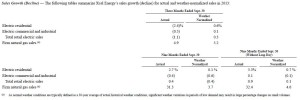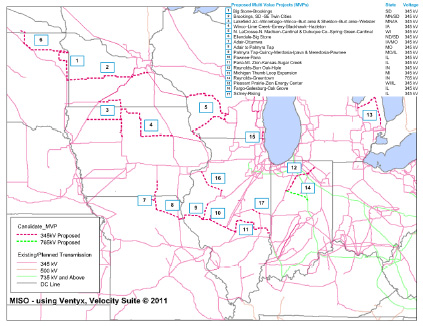State Journal reporter Judy Newman contributed to this report.
Electric demand is down… down… DOWN!
October 28th, 2013
What’s new? Well, Xcel Energy has announced its 3Q results and the 2013 demand just keeps going down!
From Seeking Alpha, the 3Q call transcript (emphasis added):
Kit Konolige – BGC Partners, Inc., Research Division
On the — your sales growth outlook, I believe you said that you are expecting 0% to 0.5% in 2013. Can you discuss the breakdown by states on that and maybe any color about commercial versus industrial versus residential? And also give us a view of the longer term sales outlook that you’re seeing at this point?
Teresa S. Madden – Chief Financial Officer and Senior Vice President
Well, sure, Kit. Let’s start with the 2013 by the states. Minnesota, we’re still projecting a decline of about 1.2%. In NSP-Wisconsin, just a slight decline. And then the other 2 jurisdiction, PSCo slightly up and SPS at about 1.2% range. But all of it netting to within the — up to 0.5%. When we look to the future, we’re looking at about, as we indicated in our guidance up to 0.5%, those are narrowing, not such a great degree in terms of the decline in NSP-Minnesota. In terms of the various classes of customers, it does vary by jurisdiction. I will say that C&I, we see the most growth in Texas with the oil and gas industry boom.
CLICK HERE FOR FULL TRANSCRIPT.
Let me repeat that tidbit:
Minnesota, we’re still projecting a decline of about 1.2%. In NSP-Wisconsin, just a slight decline.
And as we know too well, the CapX 2020 transmission project taking over Minnesota is based on their wishful-thinking projections of a 2.49% annual increase.
From Xcel Energy’s own investor page (click to enlarge):
Here’s the full 10-Q (above from p. 50):
Someone remind me — why are we paying to build this CapX 2020 transmission project?
And MISO “approval” means exactly what?
December 9th, 2011
Here it is, MTEP 11, the Midwest Transmission Expansion Plan for 2011 (CLICK HERE, look on lower right), and it’s in the news too. The main report and some appendices:
MTEP 11 Appendix A-1_2_3 – Cost Allocation
Page listing all the Appendices
MTEP Appendix e52 Detailed Proposed MVP Portfolio Business Case
Please take note that this includes not only the CapX 2020 Brookings-Hampton line (#2 on map), but also the LaCrosse-Madison line (#5 on map), the one they need to build or they’ve got a lot of system instability goin’ on.
From my perspective, the most important thing to be aware of is that MTEP 11, and the MTEPs that preceded it, are about the shift to economic dispatch and development of the electric market. At the outset, MISO studied potential benefits of this shift, and found massive economic benefits, of which they speak in their press release. The economic benefits are realized by optimizing use of lower production cost generation, and in their own words, to “displace natural gas with coal.” Don’t believe it? Read this study that ICF did for MISO:
This is the worst possible result for those of us who breathe, and means that tens of thousands of landowners will have very high voltage transmission lines on their land, taken from them by eminent domain. These projects, almost all of the MTEP projects, are not about electric reliability, they’re “need” is to deliver market transactions of electric generation from any “point A” to any “point B,” and this is a private interest, a desire for market profits, and not a public interest.
Another issue looming is “what does MISO ‘approval’ mean?” Transmission lines are regulated by states, individually, and there is a movement to strip states of their regulatory authority and transfer that to federal entities. Look no further than Obama’s transmission “fast track” proposal, naming one of the CapX 2020 projects! States must make their energy regulatory decisions in an open, transparent process and based their decisions on ratepayer and public interest. That focus is not present in federal top-down edicts. States’ rights are at issue and we need to keep on our toes so this power shift doesn’t slide through.
And it’s not “just” the ICF report above, that’s it’s all about coal is clear from prior press. Here’s an important sentence, quoting GRE’s spin-guy Randy Fordice — explaining what we all know, that the MISO effort to get the “benefits” of displacing natural gas with coal:
Coal with benefits, yesiree… Gotta hand it to Fordice for being honest!
What does Obama’s Xmsn push mean?
October 10th, 2011
Aside from unprecedented corporate toadyism? Bowing to corporate greed at public expense? Methinks it means that the feds are stomping on states’ rights, and the states will fiercely fight to preserve their authority. Despite assurances by DOE’s Lauren Azar that they won’t be doing anything they already can’t do, I’m beyond skeptical.
The feds will have one big fight on their hands, a la the fight about states’ rights, whether for consultation on NEITC transmission or their right to deny transmission permits under the NIETC regs:
NIETC designation of corridors tossed out by 9th Circuit Court!!
Denial is NOT withholding… Piedmont v. FERC
Obama’s transmission push is ostensibly based on a Memorandum of Understanding that was signed by federal agencies, note that it is about “federal lands.”
CLICK HERE for the page that claims they’ll “expanding the scope of activity beyond federal lands.” How long before they change that sentence?!?!
For lots of info about this from a more easterly perspective check here:
Here’s what it could mean in practice – a $60 million pay-out to allow the line to go through:
Obama Administration Draws Criticism For Fast-Tracking Transmission Line Project Through National Park Units
Submitted by Kurt Repanshek on October 10, 2011 – 1:41am
A decision by the Obama Administration to fast-track seven power transmission line projects, including one through several units of the National Park System, has drawn condemnation from conservation groups.
Interior Secretary Ken Salazar says the fast-tracking shows the administration’s commitment to developing “the kind of critical infrastructure we should be working together to advance in order to create jobs and move our nation toward energy independence.”
But the secretary seems tone-deaf to groups that oppose the transmission project that would run across the Appalachian National Scenic Trail and through the Delaware Water Gap National Recreation Area and the Middle Delaware National Scenic River.
“The Obama Administration has failed to protect three popular national park sites in New Jersey and Pennsylvania with today’s decision to include the controversial Susquehanna-Roseland power line project on its list of fast-tracked transmission projects,” said Bryan Faehner, the National Parks Conservation Association’s associate director for park uses.
“Susquehanna-Roseland proposes to build massive 200-foot towers and power lines across the Delaware Water Gap National Recreation Area, the Middle Delaware National Scenic River, and the Appalachian National Scenic Trail in New Jersey and Pennsylvania. Delaware Water Gap alone enjoys more than five million visitors annually – most of which come from nearby urban areas – seeking the park’s inspiring views and outstanding recreational opportunities,” he added.
“Building massive power lines across these parks will harm the very resources they were designated to protect. This development can only harm visitors’ experience to the parks and puts economic benefits to local communities at risk. Unlike other proposals mentioned on the administration’s list, the Susquehanna-Roseland power line proposal would not help bring renewable energy sources on-line. Instead, it would transmit electricity produced by dirty coal-fired power plants.”
Last month Delaware Water Gap officials announced that a new alternative developed by the applicants has been added to their environmental analysis of the project, alternative 2b. Alternative 2b would be built within the existing right-of-way of the applicants’ original proposal, alternative 2.
“Under alternative 2b, the applicants would not request any additional ROW. They have stated they can safely operate the new line within the existing ROW, which has some sections 100 feet in width,” the NRA officials said at the time. “Construction would still require additional clearing for access roads and other features.”
The administration’s announcement last week to fast-track the project also was criticized by Public Employees for Environmental Responsibility, which said the decision “is a move to bypass proper environmental review designed to protect one of the most scenic areas of the entire national park system.”
“We do not object to fast-tracking projects as long as political appointees follow the laws protecting parks and the environment–but that hasn’t happened here,” said PEER Executive Director Jeff Ruch in a press statement. “Using jobs as a pretext is misplaced. More jobs can be created by protecting parks than by trashing them.”
PEER contends that Secretary Salazar, National Park Service Director Jon Jarvis, and other Interior officials have met repeatedly with project proponents, PPL Electric Utilities of Allentown, Pennsylvania and Public Service Electric and Gas Company of Newark, New Jersey, and have already approved a route for a new power line that will cut across the Delaware Water Gap NRA and the Appalachian Trail.
As part of the deal, PEER said the draft EIS will not consider at least two alternatives that would lessen impacts to the park’s scenery but will include at least one alternative (2B) demanded by the companies that is untenable from a safety perspective. The secretary and the director have unofficially committed to the companies that the NPS will select Alternative 2, the alternative preferred by the companies but which is the most damaging to the resources and scenery of the parks, PEER argued. In return, the companies have reportedly agreed to pay $60 million for land acquisition and administration inside and near the NRA.
“This is not ‘fast track,’ it is a short circuit in which political appointees are putting their thumbs on the scale to skew the review process,” Mr. Ruch added. “It is one thing to select an alternative after the conclusion of the NEPA process, but is something else to decide on the alternative before public comment has even begun.”
© Copyright 2011 National Park Advocates, LLC.
Obama’s Transmission BS in the News
October 5th, 2011
What does Obama’s transmission “streamlining” “fast track” agenda mean for states’ authority over need for and routing of transmission?
What does Obama’s transmission “streamlining” “fast track” agenda mean for federal agencies charges with NEPA environmental review of these transmission projects?
What does Obama’s transmission “streamlining” “fast track” agenda mean for public participation and due process?
Does Obama have a clue how many landowners/voters are affected by CapX 2020?
$$$$$$$$$$$$$
These are TWO of my transmission projects he’s targeting, TWO, the CapX 2020 Hampton-LaCrosse transmission line and the Susquehanna-Roseland transmission line. Here’s the Dept. of Interior Press Release:
Obama Administration Anounces Job-Creation Grid Modernization Pilot Projects
Susquehanna-Roseland in the news:
Obama backs power line upgrade that passes through Morris County
I guess we know why he was in Cannon Falls… at least part of it… I hate to think what else might have been on the agenda.
Here’s what’s flying out in the press about Obama’s Transmission Toadyism and CapX 2020, many are pretty much just a cut and paste of the White House press release:
Rochester Post Bulletin: Obama Administration to fast track CapX 2020, other power-line projects
Minnesota Public Radio: Obama seeks fast track for powerlines in Minn., elsewhere
Here’s one with some substance:
Feds step up power line projects in 12 states, including one in Wisconsin
Once more with feeling:
What does Obama’s transmission “streamlining” “fast track” agenda mean for states’ authority over need for and routing of transmission?
What does Obama’s transmission “streamlining” “fast track” agenda mean for federal agencies charges with NEPA environmental review of these transmission projects?
$$$$$$$$$$$$$
Obama “fast tracks” transmission?!?!?!
October 5th, 2011
Changes that make me ill…
Progress? NOT! My screen just lit up from East Coast and Midwest birdies that there was a White House conference call going on, and here are some reports, the short version is that Obama is toadying for the transmission owners to ram this down our throat. Supposedly they’d conferred with “stakeholders” and funny, I never heard a peep… but this creeping federal authority is based on exactly what? What are they proposing?
They list a handful of projects, two of which I’m mired in, the CapX 2020 Hampton-LaCrosse line in Minnesota and Wisconsin, and the Susquehanna-Roseland line in New Jersey.
Here’s the map of the transmission projects they’re hyping, and look at the depiction of CapX 2020 Hampton-LaCrosse, it’s not even a route option that’s under consideration as presented in the Minnesota or Wisconsin Applications!
Here are some fascinating links — THERE’S NOTHING HERE, BLANKS:
COORDINATION OF FEDERAL AUTHORIZATIONS FOR ELECTRIC TRANSMISSION FACILITIES
Here’s where they list what’s going on for the various projects they targeted:
eTRANS FEDERAL PERMITTING TRANSMISSION TRACKING SYSTEM MAIN PAGE
And here’s the scary part, look at this language on that main page:
Leveraging this interagency collaboration and expanding the scope of activity beyond Federal lands, the Administration recently formed the Rapid Response Team for Transmission (RRTT), comprised of these same nine agencies.
So do explain, where do they get the authority for “expanding the scope of activity beyond Federal lands?”
Check these “pages” for individual projects – there’s not much there:
eTRANS FEDERAL PERMITTING TRANSMISSION TRACKING SYSTEM – SUSQUEHANNA-ROSELAND
eTRANS FEDERAL PERMITTING TRANSMISSION TRACKING SYSTEM – CAPX 2020
And check this:
There are phone numbers on the press release, but no one knows anything and I’m getting transferred around. So then I call the White House, then got forwarded to Neil Kemkar, White House Council of Environmental Quality… we shall see…
PSEG is already excited about it, PPL put out a press release too, nothing from Xcel yet that I can find:
October 5, 2011
Susquehanna-Roseland Reliability Project Named To Federal Rapid Response Team
My two basic questions:
1) What does “pilot demonstrations of streamlined federal permitting” mean? What is the authority for “pilot demonstrations of streamlined federal permitting?”
2) What is the authority for “expanding the scope of activity beyond Federal lands?”
And here’s the poop, directly from the DOE’s Lauren Azar (Senior Advisor, Office of the Secretary of Energy).
She just called, and she’s a point person on the Rapid Response Team. I haven’t seen her since she was representing American Transmission Company as it was born in the Arrowhead-Weston Transmission Project hearing in Wisconsin, was that really 10 years ago??? Anyway, I stated my concerns, she was direct and frank. My fears are still there, that this is a way to ram projects through. If not, why would they do this? These are rough notes, not quite quotes:
This is a way in which feds will work better together. Each agency will be applying their statutes.
In the past, there wasn’t a lot of coordination between the agencies, federal agencies, and the state agencies too, they can participate if they want.We’re working to figure out a way to do it, whether to do the state and federal pieces sequentially or concurrently. Where agencies doing same analysis, they can work together. We’re trying to make things work more smoothy.
We’ve talked to state Commissions in MN and WI, on Hampton and LaCrosse about working together
This is the way to undermine moving stuff to the feds
If we can do this, then the statesThere are cases where there’s delay, and cases where transmission has been turned down by the state
I’m not advocating that any authority get transferredPresidential mem0 end of August, Aug 28, was the basis for this
We’re not doing anything differently, we’re just trying to do it betterAs far as independent authority, we don’t need it, this is just doing what we can do and doing it better
She persisted with the fiction that projects are not getting permitted. Sure, there’s the PATH transmission line, but that was demonstrated not to be needed (YEAAA Piedmont Environmental Council). What others? She said there were lots of them, but no specifics. When she said that this transmission is about “clean energy,” I countered thatthat this transmission is NOT for wind, and she said we’ll have to discuss that over a beer some time. I don’t think there’s enough beer in Wisconsin to facilitate that discussion!
I greatly appreciated her call, it helped clarify the DOE’s position and intent.
Here’s the White House press release, in toto, and as you read it, underline usage of the word “streamline” and be very concerned (Toto, we ain’t in Kansas anymore):
Obama Administration Announces Job-Creating Grid Modernization Pilot Projects
Seven Transmission Projects Across 12 States Will Increase Grid Reliability and Integrate Renewable Energies
10/05/2011
Contact: Sahar Wali (CEQ) (202) 395-5428
Adam Fetcher (DOI) (202) 208-6416
Justin DeJong (USDA) (202) 720-4623
Tiffany Edwards (DOE) (202) 586-4940WASHINGTON – Demonstrating its commitment to job creation and modernizing America’s infrastructure, the Obama Administration today announced it would accelerate the permitting and construction of seven proposed electric transmission lines. This move will speed the creation of thousands of construction and operations jobs while transforming the nation’s electric system into a modern, 21st century grid that is safer and more secure, and gives consumers more energy choices.
“The President wants to get America working again. He is committed to cutting red tape and making immediate investments to put people to work modernizing our roads, bridges, airports, and energy systems,” said Nancy Sutley, Chair of the Council on Environmental Quality. “Building a smarter electric grid will create thousands of American jobs and accelerate the growth of domestic clean energy industries translating into more energy choices and cost savings for American consumers, and a more secure energy future for our country.”
These projects will serve as pilot demonstrations of streamlined federal permitting and increased cooperation at the federal, state, and tribal levels. Project developers expect that the streamlined projects will increase grid capacity and create thousands of jobs in Arizona, Colorado, Idaho, Minnesota, New Mexico, Nevada, Wyoming, Utah, New Jersey, Pennsylvania, Oregon, and Wisconsin.
“These are the kinds of job-creating projects that the President wants to see across the country,” Sutley said. “The American Jobs Act would make immediate investments in infrastructure, putting hundreds of thousands of workers back on the job across the country. These investments would not only put people to work now, but also yield lasting benefits for the economy, increasing growth in the long run.”
Building electric transmission lines involves coordination among multiple federal, state, and tribal agencies subject to permitting, review, and consultation. Improving the overall quality and timeliness of these procedures enables the federal government to help expedite new transmission lines. Adding necessary transmission infrastructure will integrate renewable electricity sources into the grid, accommodate the growing number of electric vehicles on America’s roads, help avoid blackouts, restore power more quickly when outages occur, and reduce the need for new power plants.
“Transmission is a vital component of our nation’s energy portfolio, and these seven lines, when completed, will serve as important links across our country to increase our power grid’s capacity and reliability,” said Secretary of the Interior Ken Salazar. “This is the kind of critical infrastructure we should be working together to advance in order to create jobs and move our nation toward energy independence.”
“To compete in the global economy, we need a modern electricity grid,” said Energy Secretary Steven Chu. “An upgraded electricity grid will give consumers choices while promoting energy savings, increasing energy efficiency, and fostering the growth of renewable energy resources.”
“USDA’s collaboration with other agencies to build electric transmission will help to meet our country’s electric needs in the 21st century,” Vilsack said. “These infrastructure projects will also create jobs and opportunities that will strengthen our economy to benefit households and businesses throughout the country.”
“These projects will put Americans to work building the electricity grid of the future – one that allows for more electric vehicles on the road and homes and businesses powered by renewable energy,” EPA Administrator Lisa Jackson said. “This is yet another step forward in our efforts to build a 21st century energy sector in America that is cleaner, healthier and more sustainable.”
“A modern, 21st century transmission grid that expands transmission capacity in an efficient, cost-effective manner is critical to ensuring that Americans will have reliable, reasonably priced electricity,” FERC Chairman Jon Wellinghoff said.
“It’s important that these pilot projects move forward quickly while getting the economic, cultural and sustainability benefits provided by historic preservation reviews,” said Milford Wayne Donaldson, FAIA, chairman, Advisory Council on Historic Preservation. “The pilot project approach provides an efficient means to meet our respective agencies’ legislated responsibilities. They benefit the American people while creating a model to streamline future efforts. This is good government at work.”
In October of 2009, nine Federal entities including, the White House Council on Environmental Quality (CEQ), the Department of the Interior (DOI), the Department of Agriculture (USDA), the Department of Energy (DOE), the Department of Commerce, the Department of Defense, the Environmental Protection Agency, the Federal Electric Regulatory Commission (FERC), and the Advisory Council on Historic Preservation, signed a Memorandum of Understanding increasing their coordination to expedite and simplify building of transmission lines on Federal lands.
Leveraging this interagency collaboration and expanding the scope of activity beyond Federal lands, the Administration’s recently formed Rapid Response Team for Transmission (RRTT), comprised of these same nine agencies, will accelerate responsible and informed deployment of these seven key transmission facilities by:
Coordinating statutory permitting, review, and consultation schedules and processes among involved federal and state agencies as appropriate through Integrated Federal Planning,
Applying a uniform and consistent approach to consultations with Tribal governments, and,
Expeditiously resolving interagency conflicts and ensuring that all involved agencies are fully engaged and meeting schedules.
Crossing twelve states the RRTT’s seven selected pilot project transmission lines are as follows:
* Boardman-Hemingway Line powering Oregon and Idaho:
The new 500 kilovolt (kV) transmission line proposed by Idaho Power would create an approximately 300 mile long, single-circuit electric transmission line from a proposed substation near Boardman, Oregon to the Hemingway Substation near Melba, Idaho—known as the Boardman to Hemingway Transmission Line Project or B2H Project. According to the developer of this project during peak construction, this project is estimated to create about 500 jobs in Idaho and Oregon.* Gateway West Project to bring new transmission across Wyoming and Idaho:
Jointly proposed by Idaho Power and Rocky Mountain Power, this project would add approximately 1,150 miles of new, high-voltage transmission lines between the Windstar Substation near Glenrock, Wyoming and the Hemingway Substation near Melba, Idaho. According to the developer of this project, during peak construction, it is estimated to create between 1,100 and 1,200 jobs.* Hampton-Rochester-La Crosse Line to power to Minnesota and Wisconsin:
This double- circuit capable 345 kV transmission line will run between a new substation near Hampton, Minnesota, a new substation north of Pine Island, Minnesota, and continue on to cross the Mississippi River near Alma, Wisconsin. A single circuit 345 kV line will be built in Wisconsin to a new substation in the La Crosse area. Two 161 kV lines will be built between the new substation near Pine Island and existing substations northwest and east of Rochester. According to the developer of this project, approximately 1,650 jobs will be created during peak construction.* Oregon to get additional transmission from Cascade Crossing Line:
Portland General Electric’s proposed Cascade Crossing Transmission Project includes approximately 210 miles of 500 kV transmission line from Boardman to Salem, Oregon—for the construction of four new substations, expansion of three existing substations, and upgrades to the existing transmission systems near Salem. According to the developer, Cascade Crossing is expected to create about 450 jobs during peak construction.* SunZia Transmission, LLC to bring power to New Mexico and Arizona:
SunZia Transmission, LLC plans to construct and operate up to two 500 kV transmission lines originating at a new substation in Lincoln County in the vicinity of Ancho, New Mexico, and terminating at the Pinal Central Substation in Pinal County near Coolidge, Arizona. According to the developer estimated job creation will be about 3,408 direct jobs during the construction period.* Susquehanna to Roseland Line brings new transmission to Pennsylvania and New Jersey:
PPL Electric Utilities (PPL) and Public Service Electric and Gas Company (PSE&G) have proposed the Susquehanna-Roseland power line project which includes an approximately 145-mile long 500 kV transmission line from the Susquehanna Substation in Pennsylvania to the Roseland Substation in New Jersey, and several 500 – 230 kV substations in both Pennsylvania and New Jersey. Based on the current schedule for the environmental review, the project is expected to be in service in the spring of 2015. According to the project’s developer, over 2000 jobs will be created in New Jersey and Pennsylvania.* Transwest Express to stand-up transmission from Wyoming to Utah and Nevada:
TransWest Express LLC plans to construct and operate a more than 700 mile, 600 kV, transmission line which is estimated by the developer to create 1,035-1,550 direct jobs per year at peak construction. This project will facilitate the development of new wind projects in Wyoming.For a map of the transmission line pilot projects please visit: www.doe-etrans.us
For more information on the Rapid Response Team for Transmission please visit: http://www.whitehouse.gov/administration/eop/ceq/initiatives
For more information on the Memorandum of Understanding please visit: http://www.whitehouse.gov/administration/eop/ceq/Press_Releases/October_28_2009
###







